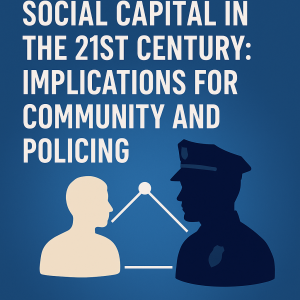Social Capital in the 21st Century: Implications for Community and Policing
 Social Capital in the 21st Century: Implications for Community and Policing
Social Capital in the 21st Century: Implications for Community and Policing
Dr. Michael Beshears
In their landmark 1982 article, “Broken Windows: The Police and Neighborhood Safety,” James Q. Wilson and George L. Kelling proposed that visible signs of disorder, such as broken windows or graffiti, signal neglect and invite further disorder and more serious crime. This concept, known as the broken windows theory, was further explored by Wesley Skogan, who examined over 40 cities and described disorder as the first step in “the downward spiral of urban decay” (Harcourt, 2001).
Building on this idea, community policing strategies incorporated principles from the broken windows hypothesis. Police departments began emphasizing the enforcement of misdemeanor laws and adopted zero-tolerance approaches to minor offenses. At the same time, residents engaged in civic activities and community collaboration, sometimes referred to as social capitalism, helped reinforce public safety efforts. While no peer-reviewed studies definitively link these social initiatives to the nationwide decline in violent crime since 1990, correlations suggest that cooperative community engagement may have contributed to the decrease alongside policing efforts (Gramlich, 2019).
However, critics such as Harcourt (2001) caution that the broken windows theory alone does not explain reductions in crime. He argues that aggressive surveillance, stop-and-frisk policies, and misdemeanor arrests likely played a more central role. Yet, the involvement of community members remains an essential complement to law enforcement strategies.
Recent decades have seen a decline in civic engagement and social capital, a phenomenon famously described by Robert Putnam as Bowling Alone (as cited in Smith, 2007). Changes in family structures, suburban sprawl, and the rise of electronic entertainment have led to a decline in face-to-face interactions and a loss of neighborhood cohesion. Generational shifts have exacerbated this trend, with younger populations, namely, baby boomers and Generation X, participating less in traditional forms of community life (Smith, 2007).
Looking ahead, there are concerns that future generations may experience even weaker social bonds. Whereas past communities gathered for holidays, children played outside, and neighbors knew one another, technology has created barriers to direct interaction. Phone calls, video chats, and indoor entertainment have largely replaced in-person connections. Observing contemporary social patterns, it is clear that many people remain unaware of their surroundings, instead being absorbed by digital devices. Scholars suggest that declining interpersonal skills may undermine community policing efforts, which rely on active participation from residents. Without a socially engaged public, the strategies that once contributed to safer neighborhoods may lose their effectiveness.
In summary, while policing strategies remain critical, fostering social connections and civic engagement is equally important. Strengthening community ties may not only complement law enforcement but also sustain safer, more resilient neighborhoods in the future.
References
Gramlich, J. (2019, January). 5 facts about crime in the U.S. Fact Tank. Pew Research Center. https://www.pewresearch.org/fact-tank/2019/01/03/5-facts-about-crime-in-the-u-s/
Harcourt, B. E. (2001). Illusion of order: The false promise of broken windows policing. Harvard University Press.
Smith, M. K. (2007). Robert Putnam, social capital and civic community. The Encyclopedia of Informal Education. Republished website, Infed. http://infed.org/mobi/robert-putnam-social-capital-and-civic-community/
About the Author:
 Dr. Beshears holds an associate degree in general studies, dual bachelor’s degrees in criminal justice and psychology from Drury University, a master’s in criminology from Indiana State University, a master’s in health services management from Webster University, and 18 additional graduate hours in public administration. He earned his Ph.D. in Business with a specialization in Criminal Justice from Northcentral University. A retired U.S. Army Master Sergeant with 22 years of honorable service, he was named Non-Commissioned Officer of the Year at two commands and is a graduate of the Army Leadership Academy. As a civilian, he has worked with local sheriff’s departments, a state drug task force, and the FBI. Dr. Beshears brings over 30 years of teaching experience, both online and in traditional classrooms, having instructed more than 50,000 students in criminal justice, corrections, and management. He has also mentored colleagues in online instruction and strategies for student success.
Dr. Beshears holds an associate degree in general studies, dual bachelor’s degrees in criminal justice and psychology from Drury University, a master’s in criminology from Indiana State University, a master’s in health services management from Webster University, and 18 additional graduate hours in public administration. He earned his Ph.D. in Business with a specialization in Criminal Justice from Northcentral University. A retired U.S. Army Master Sergeant with 22 years of honorable service, he was named Non-Commissioned Officer of the Year at two commands and is a graduate of the Army Leadership Academy. As a civilian, he has worked with local sheriff’s departments, a state drug task force, and the FBI. Dr. Beshears brings over 30 years of teaching experience, both online and in traditional classrooms, having instructed more than 50,000 students in criminal justice, corrections, and management. He has also mentored colleagues in online instruction and strategies for student success.

